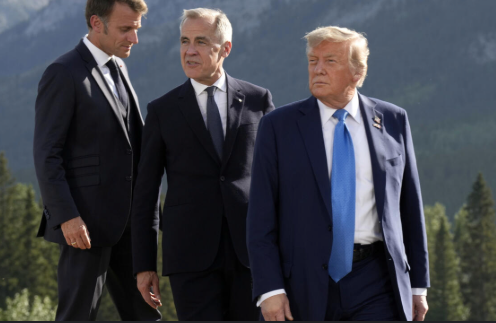In an unexpected turn of events, U.S. President Donald Trump left the G7 summit in Kananaskis, Alberta, a day earlier than scheduled, citing rising tensions in the Middle East as the reason for his abrupt departure. The 51st G7 summit, which brought to the leaders from the world’s most advanced economies to discuss pressing global issues, was overshadowed by escalating violence between Israel and Iran. Trump’s early exit ca,e just hours after a high-stakes leader’s dinner, making a dramatic shift on the summit’s tone and priorities.
This decision followed a sudden intensification of conflict in the Middle East. Israeli forces reportedly launched a series of strikes targeting Iranian military and nuclear sites, to which Iran responded with missile attacks on key Israeli cities. The rapidly deteriorating situation raised fears of a broader regional war. Trump took his social media platform, Truth Social, to issue a stark warning to Iranian citizens, urging residents of Tehran to “immediately evacuate.” The unfiltered message was met with an alarm, both for its tone and implications suggesting that a significant military escalation was either imminent or already in motion.
White House officials have confirmed that President Trump left the summit early to return to Washington for emergency security briefings. Sources revealed that key U.S. naval assets, including the USS Nimitz and USS Carl Vinson
White House Officials have confirmed that President Trump left the summit early to return to Washington for emergency security briefings. Sources revealed that key U.S. naval assets, including the USS Nimitz and USS Carl Vinson strike groups, were redirected to the region, signaling a shift to a more aggressive military posture. The Pentagon did not confirm any direct engagement plans; it emphasized the need to prepare for “any and all contingencies.” This urgency of the moment was underscored by the activation of the National Security Council and close coordination with allies in the region.
Trump’s early departure disrupted several scheduled engagements, including bilateral meetings with Ukrainian President Volodymyr Zelenskyy and Mexican President Claudia Sheinbaum. These talks were anticipated to cover critical topics such as military aid, immigration, and economic cooperation. The cancellation of these meetings not only hampered the diplomatic flow of the summit but also left other leaders scrambling to adjust their agendas. Some expressed disappointment, others acknowledged the gravity of the unfolding situation. French President Emmanuel Macron described Trump’s decision to leave as “appropriate under the circumstances,” noting that it helped bring sharper focus to the summit’s discussions on global security.
Despite these departures, Trump did lend his support, albeit informally, to a joint G7 statement calling for de-escalation in the Middle East and urging all the parties to respect international law. He declined to formally sign the communiqué, reportedly due to disagreements over language on military restraint and humanitarian
Despite the departure, Trump did lend his support—albeit informally—to a joint G7 statement calling for de-escalation in the Middle East and urging all parties to respect international law. However, he declined to formally sign the communiqué, reportedly due to disagreements over language on military restraint and humanitarian concerns. This move stirred frustration among European leaders who sought a unified front. Meanwhile, Trump’s team emphasized that the U.S. remained fully engaged and that diplomatic channels remained open.
From a broader geopolitical lens, Trump’s actions reflect his characteristic “America First” strategy: direct, highly visible, and often unilateral. His decision to prioritize U.S. national security interests over multilateral summits is consistent with past behavior. However, it also raises questions about reliability and consistency in U.S. leadership. For many allies, the summit had represented a rare opportunity to restore cohesion among Western powers. Instead, it ended in a note of uncertainty.
For ordinary citizens, particularly those in Iran and Israel, the implications of Trump’s warning and military movements are deeply unsettling. As tensions rise, civilians on both sides are bracing for the possibility of broader conflict, with fears of displacement, economic instability, and casualties. In the U.S., Trump’s supporters have praised his decisiveness, while critics warn that his rhetoric risks inflaming an already volatile situation.
In summary, Trump’s early departure from the G7 summit is emblematic of a leadership style that thrives on immediacy and spectacle. It underscores the increasingly fragile nature of global diplomacy in an age of unpredictable crises. As the Middle East crisis deepens, the world will be watching closely—not just for how the U.S. responds, but whether the international community can find a path back to stability and cooperation. Keep Reading Questiqa.us for more news.







Average Rating